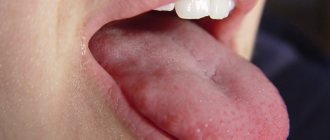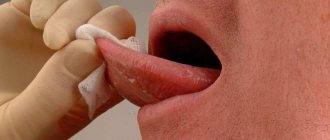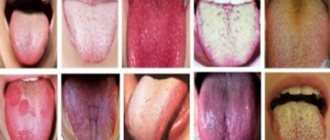Causes of gray plaque on the tongue
A substrate that has a high density is considered truly suspicious and dangerous. We list the serious reasons for the appearance of gray plaque:
- Most often, accumulations appear due to gastrointestinal ailments.
- The surface of the muscular organ becomes covered with a film in those patients who have undergone antibiotic therapy.
- With HIV infection, a gray coating forms on the tongue, as the gastrointestinal tract suffers.
- A disease such as tonsillitis provokes pathological layers. They appear due to the proliferation of harmful microorganisms that emit an unpleasant odor.
- The reasons may lie in dehydration of the body and an increase in temperature.
- It is also bad when there is excess water in the body. Water-salt metabolism is disrupted, the substrate becomes sticky, as the mucous layer inside the body increases in volume.
Very often, the tongue becomes grayish due to insufficient oral hygiene, as well as against the background of pneumonia or bronchitis. By the way, a green coating on the tongue and bitterness in the mouth is formed due to massive accumulations of bile. Usually the problem occurs against the background of pathology of the biliary system.
Glossitis - symptoms and treatment
Folded or scrotal tongue. The term “scrotal tongue” comes from the external similarity of the affected tongue to the skin of the scrotum (from the Latin scrotum - scrotum). With this form of glossitis, a deep central groove runs along the back of the tongue with adjacent cracks and folds, which can be located longitudinally or randomly. The tongue is slightly enlarged [5]. Due to atrophy of the filiform papillae, it may look “smoothed out”, but this does not affect the taste sensation [16].
Diamond-shaped or median glossitis. This is a chronic disease of the mucous membrane of the tongue with partial or complete absence of filiform papillae closer to the posterior third of the tongue. The lesion has a diamond shape, a dense texture and a red varnished color. Usually it has clear contours and does not protrude above the mucous membrane. The lesion does not cause pain, but some patients perceive it as an aesthetic defect.
Other forms of rhomboid glossitis are less common - with tuberous outgrowths and papillomatous growths. The patient then feels the presence of a foreign body on the tongue [5][16].
Desquamative or “geographical” language. With this form of glossitis, the keratinization of the tongue is partially disrupted with signs of desquamation of the epithelium - desquamation (Latin desquamo - remove scales). The papillae of a significant part of the surface of the back of the tongue are changed. The lesions take on the appearance of red spots with a diameter of 0.5 cm and desquamated whitish epithelium along the edges. The spots can merge with each other and create a pattern similar to a geographical map.
Patients often complain of pain and burning when eating food or drinks that irritate the oral mucosa, and some of them note a short-term loss of taste.
There are two forms of desquamative glossitis: migrating and fixed [16].
The fixed form is more common with moderate damage to the stomach by the bacterium Helicobacter pylori. The disease is usually accompanied by persistent atrophy and smoothness of the filiform papillae of the tongue. The size and location of the lesions does not change.
The migratory form occurs when the stomach is heavily colonized with H. pylori. Foci of desquamation are up to 2 cm in diameter, their location is constantly changing.
Also, with desquamative glossitis, the tongue may increase in volume due to inflammation of the fungiform papillae, which are located at its root. They reach 0.8 cm in diameter and are covered with a white or light gray dense coating [14].
Black "hairy" tongue. This is a rare lesion in which the keratinized epithelium of the filiform papillae located in the posterior and middle third of the dorsum of the tongue does not slough off. Because of this, the papillae acquire a brown or black color, become stiffer, grow up to 2-3 cm, and are covered with a coating ranging from green and light brown to black [16].
The tongue takes on an unaesthetic appearance, patients complain of the sensation of a foreign body in the mouth and the appearance of a gag reflex [4].
Diseases of the gastrointestinal tract. A sign of damage to the gastrointestinal tract is a grayish-white coating on the back surface of the back of the tongue. There are no pain or any other subjective sensations.
Another manifestation of gastrointestinal tract damage is swelling of the tongue with tooth marks on its lateral surfaces without visible relief disturbances. At the same time, patients may be bothered by constant biting and burning when eating hot and spicy foods. The fungiform papillae located at the root of the tongue may also enlarge. They become bright red and rise above the surrounding tissue. The listed symptoms may accompany gastritis, gastric and duodenal ulcers[5].
With hepatitis A, areas of desquamation appear on the back of the tongue. Due to atrophy of the filiform papillae, the tongue becomes smooth and red. Patients often complain that the taste of sweet and bitter foods has become less pronounced [5].
Liver cirrhosis is manifested by swelling of the sublingual veins, atrophy of the oral mucosa and deepening of the natural folds of the tongue.
Lesions of the pancreas. In acute pancreatitis, the tongue becomes covered with a yellow-white coating, and the filiform papillae increase in size. Patients are often concerned about its dryness and disturbances in taste sensitivity.
In chronic pancreatitis, a secondary deficiency of B vitamins occurs, which is manifested by pain in the tongue and protruding bright red fungiform papillae. The tongue increases in size, becomes smooth and shiny.
Cardiovascular pathology. With hypertension, blisters with bloody contents are often present on the tongue, the so-called “vesical” symptom. They can suddenly appear and burst on their own, damaging the epithelium.
Diseases of the endocrine system. With diabetes, the body is dehydrated, so dryness appears, and the vessels of the tongue become overfilled with blood. A burning sensation occurs and long-healing ulcers form. Very often, symptomatic candidiasis is found on the tongue, especially if the patient does not regulate blood glucose levels.
Insufficient function of the thyroid gland, or hypothyroidism, leads to enlargement of the entire tongue or part of it and swelling, which does not form a dimple when pressed. Due to high cholesterol levels, the tongue is slightly yellowish in color.
Diseases of the blood and hematopoietic organs. With iron deficiency anemia, there is a need to eat unusual substances, such as chalk, clay, as well as a burning sensation and pain in the tongue. It is often pale in color and slightly increased in size.
With Addison-Beermer anemia, which occurs due to impaired absorption of vitamin B12, the filiform muscles weaken. The tongue becomes smooth and as if “polished”. This condition was called “Gunter's glossitis.” Painful red inflammatory streaks and spots appear. The tongue or just its tip turns bright red, and a tingling and burning sensation occurs [5].
Acute leukemia is manifested by ulcers of irregular shapes without clear boundaries with a necrotic coating on the tongue, without rims of hyperemia (overflow of blood vessels) along the edges. Pinpoint and small blood spots and hematomas may also appear on the mucous membrane of the tongue. One of the main symptoms of this condition is heavy bleeding.
Chronic leukemia occurs much less frequently than acute leukemia and lasts longer. Characteristic ulcers and leukemic infiltrates (fluid accumulation) appear on the tongue. At the acute and chronic stages of leukemia, they lead to the formation of ulcerative-necrotic lesions, which are difficult to treat.
Agranulocytosis is characterized by a significant decrease in the blood of granulocytes - a type of leukocyte, “protective” blood cells. The disease manifests itself as non-demarcated ulcers on the tongue and, unlike acute leukemia, an inflammatory reaction around them. Due to decreased immunity and the resulting increased susceptibility of the body to fungal diseases, candidiasis may develop.
Changes in the tongue due to hypo- and avitaminosis:
- hypovitaminosis A - dryness of the mucous membrane of the tongue and a tendency to increased keratinization of the skin (hyperkeratosis);
- hypovitaminosis C - swelling of the tongue with teeth marks on it; ulcerative necrotic lesions, usually covering a significant surface area of the tongue mucosa;
- hypovitaminosis PP causes a disease called “pellagra”, in which peeling of the surface layers of the epithelium occurs and a burning sensation of the tongue, it becomes smooth, shiny and crimson - the so-called “cardinal tongue”;
- hypovitaminosis B1 is characterized by pain in the tongue and the appearance of blisters;
- hypovitaminosis B2 is manifested by burning of the tongue, atrophy of the papillae and angular cheilitis - cracks in the corners of the mouth [4].
When infected with herpes simplex virus type 1 (HSV-1), patients complain of burning pain in the tongue. Upon examination, a deep crack is visible along its midline with several branches. In their depths there are painful blistering rashes, which over time burst with the formation of erosions.
Burning mouth syndrome. In the area of the tongue there is a feeling of a burn, paroxysmal burning pain, which intensifies with overwork and stress.
Galvanism. Patients experience a metallic taste in the mouth and rawness. Upon external examination, the tongue is swollen, its vessels are filled with blood, “bald spots” of the papillae and bright red erosions appear on its sides [5].
Shades of gray plaque
Deposits may have different characteristics, covering the entire tongue or individual zones. When does a white-gray coating on the tongue indicate pathology?
- Dense and thick layer – diseases of the intestinal tract, which provoke constipation;
- Slippery, not very dense, but spread over the entire surface - this is a disruption of the liver and gastrointestinal tract;
- Thickenings at the back wall of the tongue - inflammation of the stomach or intestines;
- Whiteness around the edges and at the tip – lung diseases;
- Curdled accumulations covering both the tongue and the entire mouth - fungal infections (candidiasis) or stomatitis;
- Dryness on a pale gray background is an infection, which is accompanied by dehydration;
A dark gray coating on the tongue indicates the progression of the disease or the transition to a chronic form. So it’s not far from a critical state! It can occur with chronic gastroenteritis. The body may suffer from dehydration. A wet layer, on the contrary, indicates an excess of mucus. The dark shade is characteristic of severe epidemic diseases with fever. Too dark a color with a slight grayish tint is a symptom of cholera or Crohn's disease.
How to fight
In order to effectively deal with plaque on the tongue, the true cause of its appearance should be established. To do this, you should do a small test. In the morning, brush your teeth and tongue with a toothbrush and toothpaste, removing as much or as much plaque as possible from the surface of your tongue. Time it until it appears again. If less than three hours have passed, during which time you have not eaten or drunk anything, and it has already appeared and has a fairly dense structure, then it most likely indicates the presence of some kind of disease. If plaque begins to appear after three hours or after eating, this may indicate insufficient oral hygiene.
If plaque is a consequence of insufficient oral hygiene, it is necessary to thoroughly clean not only the surface of the tooth enamel and gums, but also the tongue and the inside of the cheeks.
Diagnostics
So, a grayish coating on the tongue can indicate many ailments. It is not easy to recognize the disease by the location of the film, color and consistency; one can only assume problems in the body. Therefore, to clarify the diagnosis, it is necessary to conduct diagnostic studies. First, the specialist interviews the patient and conducts an examination. If the situation requires it, the patient is sent for tests. He may be prescribed instrumental examinations, ultrasound, and gastroenterological examinations.
First, an adult needs to see a therapist, and the child’s parents should show the child to a pediatrician. In some cases, the patient is referred for consultation to specialized specialists. It could be:
- Infectious disease specialist;
- Otolaryngologist;
- Toxicologist;
- Pulmonologist;
- Dentist;
Dental plaque removal is often prescribed, since healthy plaque is the key to dental well-being. After all, layering is not an independent disease. This is a symptom, a sign of a particular illness.
Symptoms
The main symptom is a change in plaque color from light pink to gray .
If the disease is very severe, then the coating of the tongue is very dense, and the mouth begins to smell unpleasant. Gray and yellow color means that there are problems with the digestive system. Sometimes it is enough to adjust your diet to get rid of the problem.
It is necessary to exclude everything fried, salty and spicy, and it is better to lean on fresh vegetables and fruits. If after this the symptoms do not go away, you should contact a gastroenterologist to undergo an examination.
A rich yellow-gray tint indicates that the gallbladder or liver is not entirely healthy. In addition, this may indicate bile stagnation.
Gray coating on a child's tongue
As the child’s body is known, its mucous tissues are especially sensitive to pathological changes, even minor ones. Illnesses are immediately reflected in the receptor organ. A gray coating on a child’s tongue may indicate various diseases.
- Disturbances in the digestive tract. They are accompanied by vomiting, loose stools, pain and refusal to eat.
- Tonsillitis in the chronic phase leads to deposits not only on the tongue, but also in the throat. It is painful for the baby to swallow food, and the body temperature may rise.
- With scarlet fever, in the first days, the mucous membrane has gray deposits.
- Diphtheria provokes the formation of gray films. They cover both the palate and the throat. The disease is accompanied by a cough and is dangerous for complications.
In addition to these ailments, there are other pathologies. If the tongue is covered with a gray coating, this may mean that there are problems with the lungs, liver, and kidneys. This unpleasant phenomenon bothers the baby due to poor oral hygiene and stomatitis.
How to get rid of the problem?
After detecting gray plaque, it is necessary to strengthen control over oral hygiene, restore the body’s water balance and normalize nutrition. If you cannot get rid of the plaque, you need to consult a specialist - there is a high probability that there is a serious disease.
If gray plaque is a symptom of a disease, treatment should be prescribed exclusively by a doctor. You must follow the instructions of a specialist to get rid of gray plaque.
After medical consultation, treatment with decoctions is allowed (but they cannot completely get rid of the problem): take a teaspoon of chamomile, strawberries, sage, mint and pour a glass of boiling water, leave for thirty minutes, strain. Rinse your mouth after eating.
Treatment of gray plaque
It should immediately be noted that treatment consists of eliminating the root cause of the disease. To avoid dental problems, you should treat your teeth on time, systematically brush your tongue and rinse your mouth. It happens that a muscle organ becomes gray due to an unbalanced diet. It is enough to remove the errors and the layers will disappear. If a pathology of a specific organ is identified, then the disease should be treated by a corresponding specialist.
- For respiratory abnormalities, patients most often undergo a therapeutic course of antiviral drugs or antibiotics. Bronchitis, sinusitis, and tracheitis are often treated with physiotherapy.
- Problems with the digestive organs are solved depending on the nature of the illness. Antacids, enzymes, probiotics, and choleretic agents may be prescribed.
- If dehydration is diagnosed, the drinking regime is normalized and salt is limited.
- When the body's protective functions are reduced, vitamin complexes and immunostimulants will help.
- Candidiasis and stomatitis are treated with antiseptics and antifungal agents.
Do not self-medicate. Trust an experienced doctor. Depending on the illness, you will be prescribed antihistamines, antivirals, antimicrobials and other drugs. You may need a special diet, antispasmodics, or mineral water therapy. After proper treatment, deposits on the tongue disappear.
How to remove dark plaque on the tongue?
Patients are advised to perform oral hygiene procedures daily. It is necessary to brush your teeth and the surface of your tongue at least twice a day. It is best to use a special plastic scraper for this, which will not injure the delicate surface of the tongue. You can use special gels, which are applied to the darkened mucous membrane for a few minutes, and then rinse thoroughly and spit out the used product. You should also use dental floss at least once a week to remove food particles from hard-to-reach places. In case of acidosis, patients are prescribed to drink plenty of fluids and take soda solutions orally.
Video on how to properly clean your tongue
It is impossible to get rid of dark plaque on the tongue without treating the underlying disease. Based on the established diagnosis, the doctor prescribes treatment for each patient individually.
Drug therapy
- For stomatitis, it is necessary to rinse every two hours with local antiseptics (Hepilor, Chlorophyllipt, Tantum Verde).
- Antifungal agents are prescribed for candidiasis (Clotrimazole, Fluconazole, Pimafucin).
- Probiotics containing live bifidobacteria and lactobacilli are necessary to restore intestinal microflora (Linox, Acipol, Bifidumbacterin).
- Prebiotics stimulate the body to produce its own bacteria by containing a nutrient medium for them (Duphalac, Normaze, Lactusan).
- Drugs to strengthen the immune system are necessary to increase the body's resistance to harmful substances (Cycloferon, Ribomunil, Kagocel).
- Local disinfectants are necessary for sanitation of the oral cavity. You can use Chlorhexidine, Rezocin solution, Salicylic alcohol.
- Drugs that stimulate the secretion of gastric juice are necessary for gastritis with low acidity (Limontar, Prozerin, Etimizol).
- Antibacterial agents are needed for the treatment of aggressive types of gastritis (Cephalexin, Enterofuril, Furazolidone).
- Sorbents are used to eliminate toxic substances from the body (activated carbon, Enterosgel).
- Antacids are necessary for gastritis with high acidity and heartburn (Rennie, Phosphalugel, Maalox).
- Preparations to enhance the protection of the gastric mucosa (De-Nol, Biogastron, Venter).
- Vitamins B and PP must be used if they are deficient in the body.
Diet
Sometimes, to get rid of dark plaque on the tongue, it is enough to follow a special diet for a long time, aimed at normalizing the acid-base balance and metabolism. To alkalize the body, you should consume more of the following foods:
- greenery;
- citruses;
- avocado;
- cabbage;
- tomatoes;
- potato;
- radish;
- turnip;
- garlic;
- dried fruits.
For the body to function properly, it is necessary to consume more “alkaline” foods.
If there is a lack of nicotinic acid, patients are advised to increase their consumption of meat, liver, egg yolks, milk, legumes, buckwheat, and peanuts. An adult needs to consume about 15 mg of vitamin PP per day.
Also, for the health of the body, it is worth reducing the consumption of the following foods:
- sweets;
- carbonated drinks;
- fast food;
- smoked meats;
- fatty, salty, canned foods;
- alcohol;
- coffee.
Video about alkaline nutrition
Folk remedies
If dark plaque was discovered for the first time, you can try to get rid of it yourself within two days. For this purpose, rinsing with a decoction of chamomile, sage, and oak bark is suitable. If there are no changes and the tongue has a dark tint, you should consult a doctor. In some situations, after consultation with a specialist, you can use various folk recipes.
Anti-inflammatory infusion
Take yarrow, oregano, plantain and linden flowers in equal proportions. Grind all the ingredients thoroughly, take one teaspoon of the resulting mixture and pour a glass of boiling water over it. Cover the cup tightly and leave to steep for three hours. Drink 100 ml of the product every day twice a day before meals. The course of administration is two weeks; before re-use, you should take a break for ten days.
Herbal infusions help relieve inflammation and improve the functioning of the gastrointestinal tract
Flax seed decoction
Flax seeds are recommended for constipation and inflammation of the gastric mucosa. During cooking, this plant releases a large amount of mucus, which has enveloping properties. The seeds also contain a large amount of minerals and trace elements: potassium, calcium, magnesium, iron, OMEGA 3 and 6 fatty acids, vitamins A, D, E, K, C, PP, B. To prepare the decoction, you need to take 8 teaspoons of seeds flax and pour a liter of water over them, bring to a boil and cook for about ten minutes over low heat. Cool the product, strain and drink a glass in the morning on an empty stomach.









